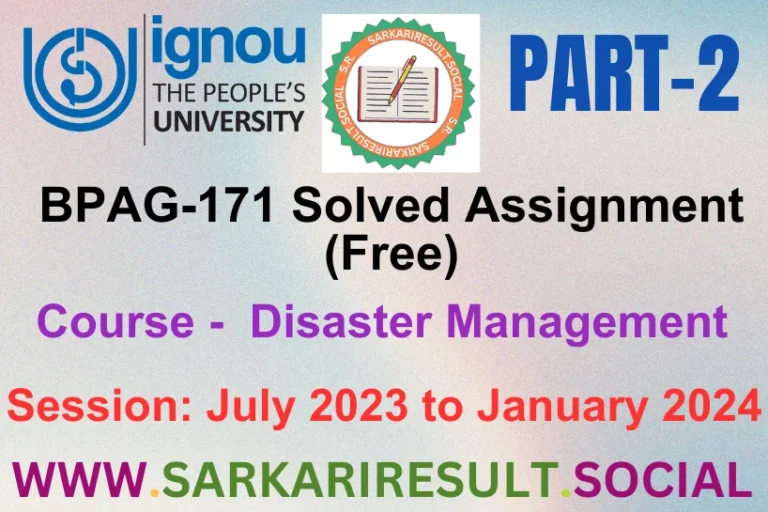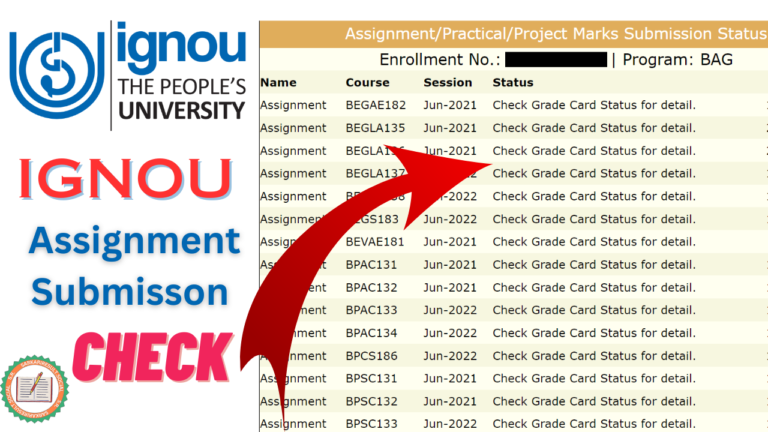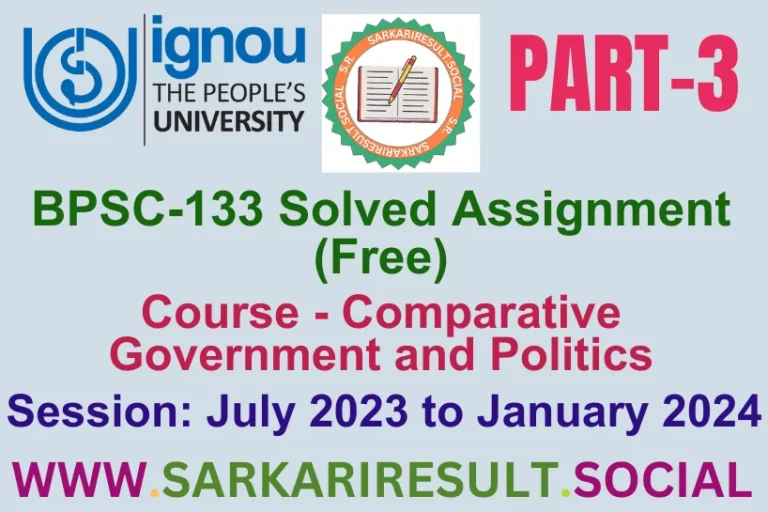MPCE 012 IGNOU Solved Assignment 2023-24 (free) Part 2

MPCE 012 IGNOU Solved Assignment 2023-24 (free) Part 2
“Explore the world of Psychodiagnostics (MPCE 012) IGNOU Solved Assignment 2023-24 (free) Part 2 for July 2023-January 2024.

Q.4 Define psychodiagnostics. Explain the variable domains of psychological assessment.
Ans. Psychodiagnostics is a branch of psychology that involves the systematic assessment and evaluation of an individual’s psychological functioning, including cognitive, emotional, behavioral, and interpersonal aspects. It aims to understand, describe, and diagnose mental health conditions, psychological disorders, and personality traits. Psychodiagnostics is fundamental in clinical psychology, counseling, psychiatry, and various fields where mental health assessment and intervention are critical.
Variable Domains of Psychological Assessment:
Psychological assessment encompasses a wide range of variable domains that collectively provide a comprehensive understanding of an individual’s psychological well-being. These variable domains include:
1. Cognitive Functioning: Assessments in this domain evaluate an individual’s cognitive abilities, including memory, attention, problem-solving, reasoning, and language skills. Cognitive assessments help diagnose conditions such as dementia, learning disabilities, and cognitive impairment.
2. Emotional Functioning: Emotional assessments examine an individual’s emotional experiences, regulation, and expression. This domain covers mood disorders, anxiety disorders, and emotional intelligence. Tools like self-report questionnaires and interviews are used to assess emotional states.
3. Personality Assessment: Personality assessments aim to uncover an individual’s enduring traits, behaviors, and thought patterns. The most well-known is the Minnesota Multiphasic Personality Inventory (MMPI), used to diagnose personality disorders, but there are various other methods and tests, including projective tests like the Rorschach Inkblot Test.
4. Behavioral Assessment: Behavioral assessments focus on observing and measuring an individual’s overt behaviors. This domain is essential in understanding behavioral disorders, such as attention-deficit/hyperactivity disorder (ADHD), conduct disorders, and addiction. Behavior rating scales and direct observations are common tools in this domain.
5. Interpersonal Functioning: Interpersonal assessments explore an individual’s social interactions, relationships, and communication skills. They are crucial in diagnosing conditions related to social anxiety, attachment disorders, and interpersonal conflicts. The Interpersonal Circumplex, for instance, assesses interpersonal traits.
6. Developmental Assessments: These assessments are used to evaluate an individual’s developmental milestones and progress, especially in children and adolescents. Developmental domains include physical, cognitive, social, and emotional development. Assessments such as the Bayley Scales of Infant and Toddler Development are used in this domain.
7. Neuropsychological Assessment: Neuropsychological assessments focus on the relationship between brain function and behavior. They are critical in diagnosing conditions related to brain injuries, neurodegenerative diseases, and cognitive impairments. The Montreal Cognitive Assessment (MoCA) is an example.
8. Intelligence Testing: Intelligence tests, like the Wechsler Intelligence Scale for Children (WISC) or the Stanford-Binet Intelligence Scales, measure an individual’s intellectual abilities, including verbal and non-verbal reasoning, problem-solving, and memory. They help identify intellectual disabilities and giftedness.
9. Clinical Interviews: Interviews are a fundamental aspect of psychological assessment across all domains. They allow clinicians to gather detailed information about an individual’s history, symptoms, and subjective experiences, aiding in diagnosis and treatment planning.
10. Sociodemographic Factors: Assessments also consider sociodemographic variables such as age, gender, culture, ethnicity, and socioeconomic status. These factors can influence an individual’s psychological functioning and are important in providing culturally sensitive and contextually relevant assessments.
11. Environmental and Contextual Factors: Assessments often take into account an individual’s living environment, family dynamics, and life stressors. These factors help clinicians understand the context in which psychological issues arise and inform treatment strategies.
12. Functional Impairment: Assessments evaluate the extent to which psychological symptoms and disorders impact an individual’s daily functioning, including their ability to work, socialize, maintain relationships, and engage in daily activities.
Psychological assessments typically involve a combination of standardized tests, self-report questionnaires, interviews, observations, and collateral information from multiple sources. Clinicians use the information gathered across these variable domains to make accurate diagnoses, develop treatment plans, and provide appropriate interventions to improve an individual’s psychological well-being and overall quality of life. The comprehensive nature of psychological assessments ensures a holistic understanding of an individual’s psychological profile, facilitating effective therapeutic strategies.
BGDG-172 IGNOU Solved Assignment 2023-24 (free)
Q.5 Differentiate between descriptive and predictive assessments.
Ans. Descriptive and Predictive Assessments: Descriptive and predictive assessments are two distinct approaches used in the field of assessment and evaluation. They serve different purposes and provide unique insights into various domains, such as education, psychology, and business. Below, we differentiate between these two assessment types in detail:
Descriptive Assessments:
1. Purpose: Descriptive assessments aim to provide a comprehensive and detailed picture of an individual’s or group’s current status, characteristics, or performance. They focus on understanding the present rather than making predictions about the future.
2. Information Gathering: These assessments gather data about an individual’s or group’s attributes, behaviors, or characteristics. This data is used to describe and summarize the current situation or state of affairs.
3. Scope: Descriptive assessments are retrospective, emphasizing what has already occurred. They are valuable for summarizing historical data or providing a snapshot of the current state of affairs.
4. Examples: In education, descriptive assessments may include standardized tests to assess students’ current knowledge or surveys to understand students’ attitudes and preferences. In clinical psychology, diagnostic assessments provide a detailed description of a person’s mental health symptoms and conditions.
5. Data Analysis: Data from descriptive assessments are typically analyzed using descriptive statistics, such as means, frequencies, and percentages, to summarize and present the information clearly.
6. Use Cases: Descriptive assessments are used for various purposes, including educational program evaluation, needs assessment, clinical diagnosis, and market research. They are valuable when a detailed understanding of the current situation is needed to inform decision-making.
Predictive Assessments:
1. Purpose: Predictive assessments focus on making forecasts or predictions about future outcomes or trends based on current data. They aim to anticipate what may happen under specific conditions or scenarios.
2. Information Gathering: These assessments collect data that can be used to build models, algorithms, or predictors. This data is analyzed to identify patterns and relationships that can inform predictions.
3. Scope: Predictive assessments are forward-looking, emphasizing the ability to forecast future events or trends based on historical or current data.
4. Examples: Credit scoring models predict a person’s creditworthiness based on their financial history. In education, predictive assessments may involve using prior academic performance and standardized test scores to forecast future academic success.
5. Data Analysis: Predictive assessments involve sophisticated statistical analyses, such as regression analysis, machine learning, and data modeling, to develop predictive models based on historical data.
6. Use Cases: Predictive assessments are widely used in fields like finance (credit risk assessment), marketing (customer behavior prediction), healthcare (disease risk prediction), and weather forecasting. They are valuable when organizations need to make informed decisions about future events or trends.
Key Differences:
1. Focus: Descriptive assessments focus on summarizing and describing current data, while predictive assessments focus on making forecasts or predictions about future outcomes.
2. Purpose: Descriptive assessments aim to understand the present, inform current decision-making, and summarize historical data. Predictive assessments aim to anticipate future events or trends to guide future decision-making.
3. Data Analysis: Descriptive assessments use basic descriptive statistics to summarize data, while predictive assessments involve complex statistical modeling and analysis techniques to build predictive models.
4. Temporal Orientation: Descriptive assessments are retrospective, emphasizing what has already happened. Predictive assessments are prospective, emphasizing what is likely to happen in the future.
5. Examples: Descriptive assessments include diagnostic assessments, survey research, and program evaluation. Predictive assessments include credit scoring, sales forecasting, and predictive analytics.
In summary, descriptive assessments provide a detailed snapshot of the current state of affairs, while predictive assessments use data to make informed forecasts about future outcomes. Both types of assessments have their unique strengths and are applied in various fields to support decision-making processes.
BEGAE 182 IGNOU Solved Assignment 2023-24 (free)
Q.6 Elucidate Mental Status Examination.
Ans. Mental Status Examination (MSE) is a structured assessment conducted by mental health professionals, such as psychiatrists, psychologists, and clinical social workers, to evaluate an individual’s current mental and emotional state. It provides valuable insights into a person’s cognitive, emotional, and psychological functioning. MSE is an essential component of clinical evaluations, psychiatric assessments, and diagnostic processes. Here, we elucidate the key components of an MSE:
1. Appearance and Behavior: The examiner observes the individual’s physical appearance, grooming, posture, facial expressions, and motor behavior. Any abnormalities, such as disheveled appearance or unusual movements, are noted. This component offers initial impressions of the individual’s emotional state and self-presentation.
2. Mood: Mood refers to the individual’s predominant emotional state at the time of assessment. The examiner inquires about the person’s mood, whether it is described as sad, anxious, euphoric, irritable, or any other emotional state. Shifts in mood during the assessment are also considered.
3. Affect: Affect represents the emotional expression displayed by the individual during the examination. It includes observing whether the person’s affect is congruent with their mood. Affect can range from flat (lack of emotional expressiveness) to blunted, labile (quickly changing), or inappropriate.
4. Thought Process: Thought process refers to how an individual’s thoughts are organized and communicated. Examiners assess thought processes for coherence, logic, and any evidence of thought disorders, such as derailment (incoherent speech) or flight of ideas (rapid, tangential thinking).
5. Thought Content: Thought content examines the specific ideas, beliefs, or preoccupations expressed by the individual. Examiners look for signs of delusions (false, fixed beliefs), obsessions, phobias, and suicidal or homicidal thoughts.
6. Perceptions: The examination evaluates whether the individual is experiencing perceptual disturbances, such as hallucinations (false sensory perceptions). It explores auditory, visual, tactile, or olfactory hallucinations, if present.
7. Cognitive Functioning: Cognitive functioning assesses various domains of cognitive abilities, including attention, memory, orientation, and executive function. The examiner may ask questions to evaluate the person’s cognitive skills and ability to think clearly.
8. Insight and Judgment: Insight assesses the individual’s awareness and understanding of their own mental health and condition. Judgment pertains to their ability to make appropriate decisions in various life situations. Impaired insight and judgment can indicate mental health issues.
9. Speech: The examiner evaluates the individual’s speech patterns, rate, volume, and coherence. Disturbances in speech, such as pressured speech (rapid, difficult to interrupt), may provide diagnostic clues.
10. Sensorium and Orientation: Sensorium refers to the individual’s overall awareness of their surroundings and the current situation. Orientation assesses their awareness of time, place, and person. Impaired orientation may indicate cognitive impairment.
11. Memory: Memory assessment includes testing short-term and long-term memory, as well as immediate and delayed recall. It helps determine whether there are deficits in memory function.
12. Insight and Judgment: Insight assesses the individual’s awareness and understanding of their mental health condition and the need for treatment. Judgment evaluates their ability to make appropriate decisions in various life situations.
MSE is a dynamic process that involves ongoing observation and interaction between the examiner and the individual being assessed. It provides a snapshot of the person’s mental state at the time of evaluation, helping clinicians make diagnoses, formulate treatment plans, and monitor progress over time.
It’s important to note that while MSE is a valuable tool in mental health assessment, it should be used in conjunction with other assessments, interviews, and psychological tests to ensure a comprehensive understanding of an individual’s mental health and psychological functioning. Additionally, cultural competence and sensitivity are crucial in conducting MSE, as cultural factors can influence how individuals express their mental and emotional states.
Q.7 Delineate the characteristics and explain the administration of Stanford-Binet Scale.
Ans. Characteristics of the Stanford-Binet Intelligence Scales:
The Stanford-Binet Intelligence Scales, now in its fifth edition (SB-5), is a widely used intelligence test designed to measure cognitive abilities in individuals from early childhood to adulthood. It is known for its comprehensive assessment of intellectual functioning and provides valuable information about an individual’s cognitive strengths and weaknesses. Here are the key characteristics of the Stanford-Binet Scale:
BANC 131 IGNOU Solved Assignment 2023-24 (free) Part-3
1. Comprehensive Assessment: The Stanford-Binet assesses a wide range of cognitive abilities, including verbal and non-verbal reasoning, memory, problem-solving, and quantitative reasoning. It provides a detailed profile of an individual’s intellectual functioning.
2. Age Range: The SB-5 is designed to assess individuals from 2 to 85+ years of age, making it applicable to a broad age range. It includes separate age-appropriate scales for children, adolescents, and adults.
3. Standardization: The test is standardized, meaning that it has been administered to a large, representative sample of individuals to establish norms and provide a basis for comparing an individual’s performance to that of the general population.
4. Reliability and Validity: The SB-5 has demonstrated high levels of reliability (consistency of results) and validity (the ability to measure what it intends to measure) through extensive research and testing.
5. Subtests: The test consists of a variety of subtests that assess different cognitive abilities. These subtests include tasks like vocabulary knowledge, pattern analysis, quantitative reasoning, and memory recall.
6. Composite Scores: Scores from individual subtests are combined to calculate composite scores that represent broader cognitive domains, such as fluid reasoning, knowledge, and working memory.
7. Adaptive Testing: The SB-5 uses a computerized adaptive testing (CAT) approach for some subtests. This means that the difficulty level of items presented to the test-taker adjusts based on their previous responses, allowing for a more efficient and precise assessment.
Administration of the Stanford-Binet Scale:
The administration of the Stanford-Binet Scale involves several steps to ensure accuracy and reliability in assessing an individual’s cognitive abilities. Here’s an overview of the administration process:
1. Preparation: The examiner gathers the necessary materials, including the test manual, record forms, and any required testing equipment (e.g., a computer for adaptive testing). They also prepare the testing environment to minimize distractions.
2. Introduction: The examiner introduces themselves and explains the purpose of the assessment to the test-taker. They ensure that the test-taker is comfortable and understands the instructions.
BANC 131 IGNOU Solved Assignment 2023-24 (free) Part-2
3. Subtest Administration: The examiner presents the specific subtests in a standardized manner, following the instructions provided in the test manual. Subtests may include tasks like solving puzzles, answering questions, or completing visual patterns.
4. Scoring: The examiner scores the test-taker’s responses according to predetermined scoring criteria. Some subtests may require immediate scoring, while others may be scored later based on recorded responses.
5. Data Entry: If computerized adaptive testing is used, the examiner enters the test-taker’s responses into the testing software. The software adjusts the difficulty of subsequent items based on previous performance.
6. Composite Score Calculation: After completing all subtests, the examiner calculates composite scores for various cognitive domains. These composite scores provide an overall assessment of the individual’s cognitive abilities.
7. Interpretation: The examiner interprets the results, considering the individual’s performance in relation to age-appropriate norms. They generate an IQ score that reflects the individual’s intellectual functioning compared to the general population.
8. Feedback and Reporting: The examiner provides feedback to the test-taker or their guardian, if applicable. A comprehensive report is often generated to summarize the results and provide recommendations for educational or clinical interventions if needed.
It’s important to note that the Stanford-Binet Scale should be administered by trained and qualified professionals who are familiar with the test’s administration procedures and interpretation. The results of the assessment can be used in various settings, including educational planning, clinical diagnosis, and research, to gain insights into an individual’s cognitive abilities and inform decision-making.
Q.8 Discuss the stages and steps in psychodiagnostics.
Ans. Stages and Steps in Psychodiagnostics:
Psychodiagnostics is a systematic process used in psychology and mental health to assess, diagnose, and understand an individual’s mental and emotional well-being. It involves several stages and steps to gather comprehensive information and formulate accurate diagnoses. Here are the key stages and steps in psychodiagnostics:
Stage 1: Referral and Initial Contact
1. Referral: The process typically begins with a referral from a healthcare provider, school, employer, or the individual seeking assessment themselves. The referral outlines the reason for the evaluation and the specific questions to be addressed.
2. Initial Contact: The clinician or evaluator establishes initial contact with the client or their guardian. They explain the assessment process, obtain informed consent, and address any questions or concerns.
Stage 2: Assessment Planning
3. Information Gathering: The evaluator collects relevant background information, including medical history, family history, educational history, and any existing documentation (e.g., previous assessments, medical records).
BANC 131 IGNOU Solved Assignment 2023-24 (free) Part-1
4. Assessment Objectives: The evaluator clarifies the goals and objectives of the assessment. They identify the specific psychological constructs to be evaluated (e.g., intelligence, personality, mood) and select appropriate assessment tools.
Stage 3: Assessment Administration
5. Selection of Assessment Tools: Based on the assessment objectives, the evaluator chooses standardized assessments, questionnaires, interviews, or observation methods. These tools may include intelligence tests, personality inventories, or symptom checklists.
6. Test Administration: The evaluator administers the selected assessments according to standardized procedures. They ensure a controlled and comfortable testing environment and provide clear instructions to the client.
7. Data Collection: During testing, the evaluator gathers data on the client’s responses, behaviors, and performance. This stage may involve cognitive, emotional, and behavioral assessments.
Stage 4: Data Analysis and Interpretation
8. Scoring: For standardized assessments, the evaluator scores the client’s responses following established scoring guidelines. This yields numerical scores that can be compared to normative data.
9. Data Integration: The evaluator integrates data from various assessment tools, considering the client’s history and presenting concerns. They look for patterns and discrepancies in the data.
10. Clinical Judgment: Data analysis involves clinical judgment to make sense of the findings. The evaluator interprets the results in the context of the client’s unique background and current circumstances.
Stage 5: Diagnosis and Formulation
11. Diagnosis: If applicable, the evaluator assigns a diagnosis based on established criteria (e.g., DSM-5 for mental disorders). The diagnosis reflects the presence of specific symptoms or conditions.
12. Case Formulation: The evaluator formulates a comprehensive understanding of the client’s psychological functioning, including factors contributing to their current state. This may involve identifying strengths, weaknesses, and potential treatment targets.
Stage 6: Feedback and Reporting
13. Feedback: The evaluator provides feedback to the client or their guardian. They discuss assessment results, diagnoses, and treatment recommendations. The client’s questions and concerns are addressed.
14. Report Writing: A detailed assessment report is generated, summarizing the evaluation process, findings, and recommendations. This report is often shared with other professionals involved in the client’s care, such as therapists or physicians.
Stage 7: Treatment Planning
15. Treatment Recommendations: Based on the assessment results, the evaluator collaborates with the client and, if applicable, their treatment team to develop an individualized treatment plan. This plan outlines therapeutic interventions, goals, and strategies for improvement.
Stage 8: Follow-Up and Monitoring
16. Treatment Implementation: The client begins the recommended treatment, which may include therapy, medication, or other interventions. Progress is monitored over time.
17. Reassessment: Periodic reassessment may be conducted to track changes in the client’s psychological functioning and treatment progress. This helps determine whether adjustments to the treatment plan are necessary.
Psychodiagnostics is a dynamic and collaborative process that requires careful planning, ethical considerations, and ongoing communication between the evaluator and the client. It plays a crucial role in guiding treatment, promoting well-being, and enhancing the client’s quality of life.
BANC 132 IGNOU Solved Assignment 2023-24 (free) Part-1







